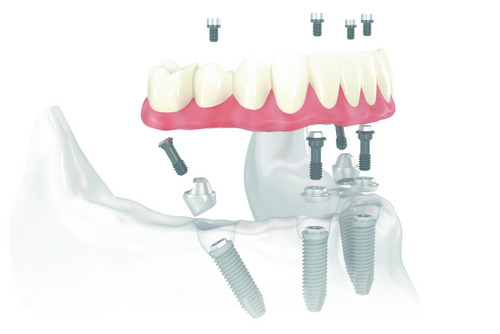
For many patients seeking dental implants, the condition of their jawbone plays a critical role in the success of the procedure. At Florida Prosthodontics, we often see cases where bone loss in the jaw prevents immediate implant placement. In these situations, bone grafting for dental implant preparation becomes an essential part of the treatment plan.
What Is Bone Grafting for Dental Implant Preparation?
Bone grafting is a surgical procedure used to rebuild or strengthen the jawbone. When teeth are lost due to trauma, decay, gum disease, or other factors, the jawbone in that area can begin to resorb or shrink over time. This bone loss compromises the stability needed for a dental implant.
Bone grafting for dental implant preparation involves adding new bone or bone-like material to the jaw where it is deficient. The goal is to create a strong, dense foundation into which an implant can be securely placed. Without sufficient bone volume, implants may not be viable, or they may fail over time.
Why Is Bone Grafting Necessary?
You may need bone grafting for several reasons before receiving a dental implant:
- Bone loss after tooth extraction
It’s common to lose bone within the first year after a tooth is extracted. Grafting helps restore this loss before implants are placed.
- Advanced gum disease (periodontitis)
Periodontitis can damage both gum tissue and the bone underneath. Bone grafting rebuilds this lost support.
- Injury or trauma
A blow to the jaw or facial injury may lead to localized bone damage that requires reconstruction before implant surgery.
- Developmental defects
Some patients naturally lack sufficient bone in certain areas of the jaw due to congenital issues or past surgeries.
- Sinus expansion
For upper jaw implants, bone grafting may be necessary to lift the sinus cavity (sinus lift procedure) to make room for an implant.
At Florida Prosthodontics, we use advanced imaging to assess bone volume and density. If bone loss is detected, a personalized bone grafting plan is created to ensure the highest chance of implant success.
Types of Bone Grafts Used in Dental Implant Preparation
There are several types of bone grafts available. The choice depends on the patient’s needs, medical history, and preferences.
1. Autografts
Bone is harvested from the patient’s own body, usually from the chin, jaw, or hip. This method is highly effective because the body is less likely to reject its own tissue.
2. Allografts
Donor bone is obtained from a tissue bank. Allografts are safe, sterilized, and widely used. They eliminate the need for a second surgical site.
3. Xenografts
Bone material is sourced from another species, usually bovine (cow). It is processed for safety and can serve as a scaffold for new bone growth.
4. Alloplasts
Synthetic materials like calcium phosphate or hydroxyapatite are used to stimulate bone regeneration. These are biocompatible and effective in many cases.
Each of these materials has its own benefits and use cases. Our team at Florida Prosthodontics will help you decide which option is best for your condition.
The Bone Grafting Procedure: Step by Step
Bone grafting is a minor surgical procedure that can be completed in our office. Here’s what you can typically expect:
Step 1: Consultation and Planning
A comprehensive exam, including digital X-rays or 3D imaging (CBCT scan), will be performed to assess bone structure and determine the extent of grafting needed.
Step 2: Anesthesia
Local anesthesia is used to numb the area. Sedation options may be available if you’re nervous or undergoing a more extensive graft.
Step 3: Graft Placement
A small incision is made in the gum to expose the bone. The grafting material is placed and secured in the targeted area. A membrane may be placed over the graft to protect it and promote healing.
Step 4: Sutures and Healing
The gum is stitched closed. Healing and bone integration usually take three to six months, depending on the size of the graft and your individual healing rate.
Step 5: Implant Placement
Once the graft has fused with your natural bone, you’ll be ready for implant surgery. In some cases, implants can be placed at the same time as the graft if the bone volume allows.
What to Expect After Bone Grafting
Most patients experience mild to moderate discomfort for a few days following bone grafting. This can usually be managed with over-the-counter pain relievers or prescribed medications.
Common post-op symptoms include:
- Minor swelling or bruising
- Soreness at the graft site
- Temporary changes in chewing or speech
We provide all patients with detailed aftercare instructions to ensure a smooth recovery. Good oral hygiene, proper nutrition, and avoiding strenuous activity will promote healing and reduce the risk of complications.
Risks and Complications
While bone grafting is a safe and routine procedure, as with any surgery, there are potential risks. These may include:
- Infection at the graft site
- Graft failure (rare, especially with proper care)
- Gum recession around the graft
- Nerve damage (if working near a major nerve)
- Reaction to anesthesia
Choosing an experienced provider, like the specialists at Florida Prosthodontics, significantly reduces the risk of complications. We follow strict protocols to ensure safety and success.
Bone Grafting and Dental Implant Success
One of the most important benefits of bone grafting for dental implant preparation is the increased likelihood of implant success. Implants rely on a strong, stable bone foundation. Without it, they may loosen, shift, or fail altogether.
By restoring bone structure before placing the implant, you are:
- Providing a strong anchor for the implant post
- Improving the integration of the implant with the bone
- Enhancing the final appearance of your dental restoration
- Ensuring long-term functionality and durability
At Florida Prosthodontics, we often say that successful implants begin with healthy bone. Bone grafting sets the stage for the confident, permanent smile you’re aiming for.
Long-Term Care After Bone Grafting and Implant Placement
Once your dental implant is in place, long-term success depends on maintaining excellent oral hygiene and visiting your dentist regularly. Tips for post-treatment care include:
- Brushing and flossing twice daily
- Using antimicrobial mouth rinses
- Avoiding smoking and tobacco products
- Scheduling routine cleanings and exams
Implants and grafts do not decay, but the surrounding gum and bone must remain healthy. Our team will monitor your progress and provide customized recommendations to protect your investment.
Why Choose Florida Prosthodontics?
We understand that the idea of bone grafting can feel overwhelming. That’s why our team is committed to patient education, comfort, and transparency. When you choose Florida Prosthodontics, you can expect:
- A full-service prosthodontic team with advanced surgical training
- State-of-the-art diagnostic technology and surgical techniques
- Personalized treatment plans tailored to your health and goals
- Emphasis on aesthetics, function, and long-term outcomes
- A caring, supportive environment from consultation to follow-up
Whether you’re missing one tooth or several, we’ll guide you through every step of your restoration process. Our goal is to help you achieve a beautiful, fully functional smile built on a strong foundation.
Ready to Take the First Step?
If you’ve been told you’re not a candidate for dental implants due to bone loss, you’re not out of options. Bone grafting for dental implant preparation can restore your oral structure and open the door to permanent, life-changing dental solutions.
Schedule a consultation with Florida Prosthodontics today. Let us help you rebuild your foundation and restore your confidence, one tooth at a time.
Learn more about our bone grafting and implant services. Book your appointment now.






 Merritt Island
Merritt Island